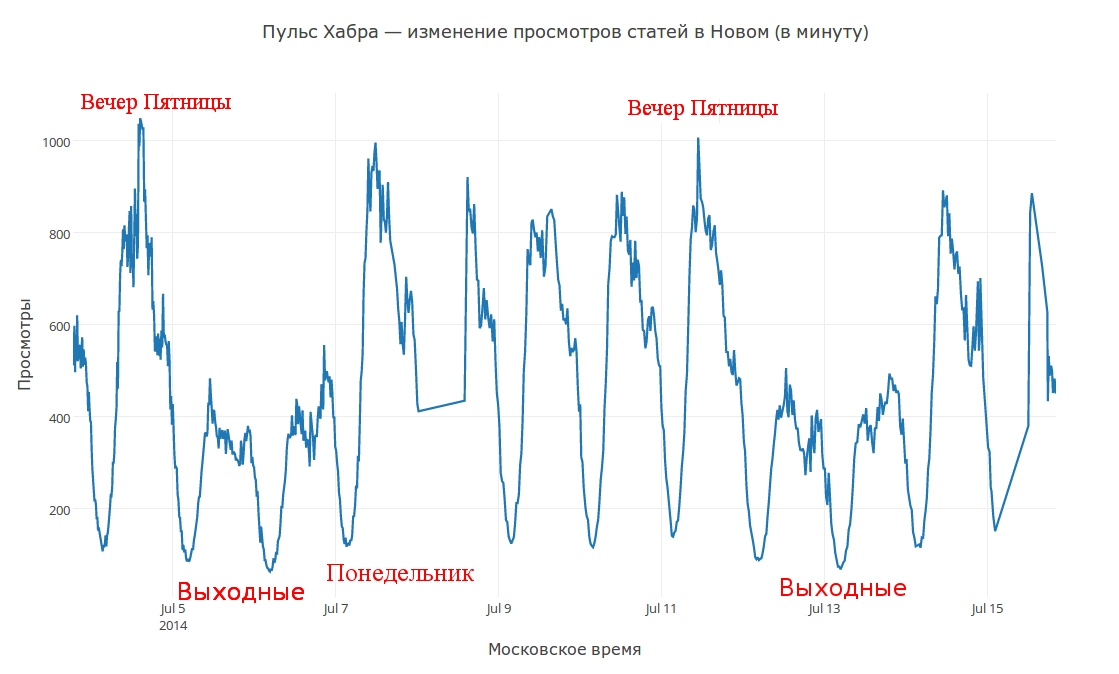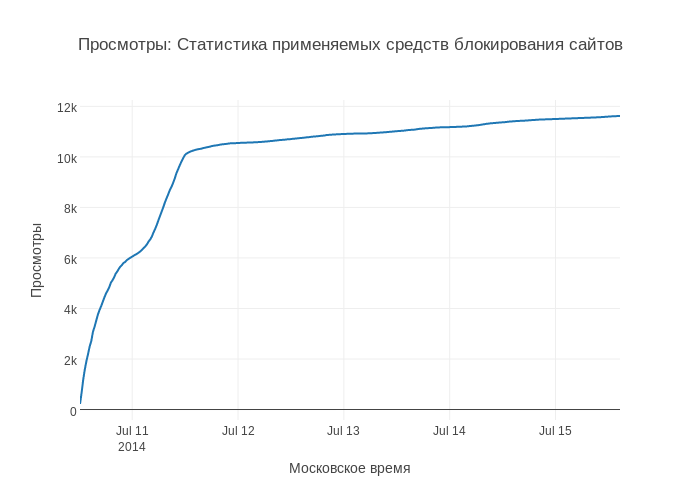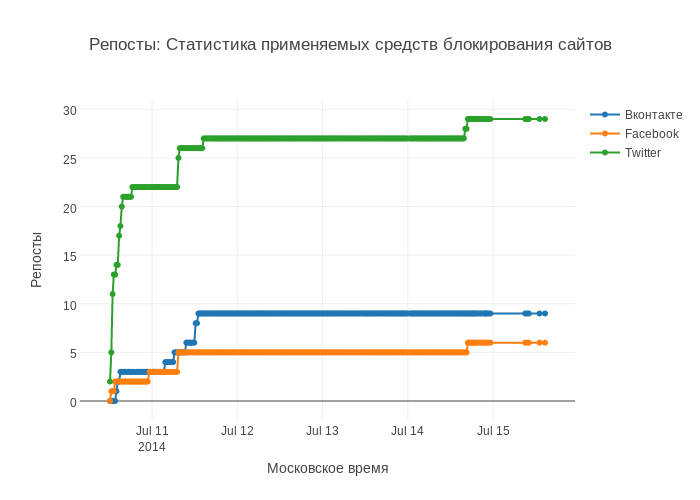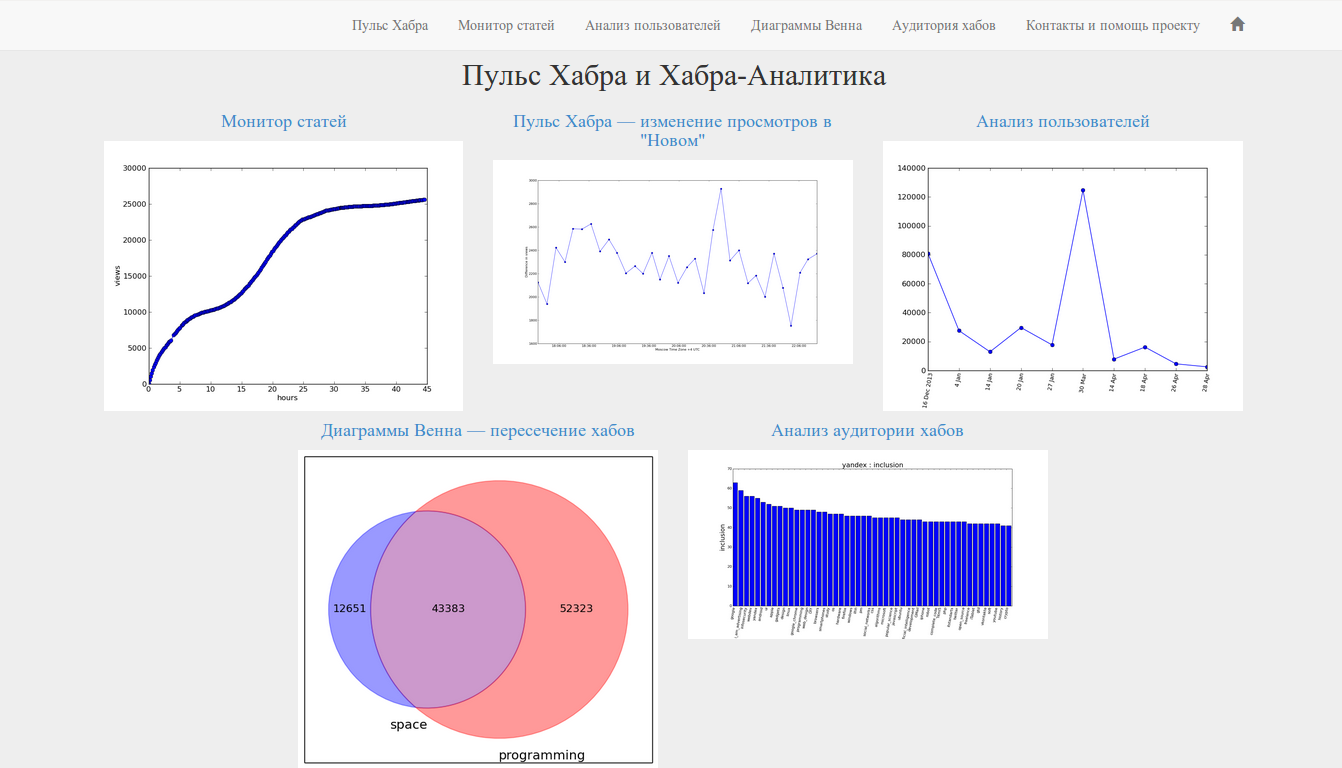Syndrome of a step and a cut of attendance of Habr
For the last couple of weeks I have been closely following Habr’s work with the help of Habr-analytics and decided to collect my observations in an article. Today we will discuss: when and in what quantity they read Habr; what is the "step syndrome"; how to get data about your articles and how to analyze them.

(the interactive version is available here and if the site crashes, then here )
The most interesting facts from the graph:
One fine day we will have our own iconosquare with text mining and benders!
Since the 1st of July, over a hundred articles have been analyzed and almost all of them have a “step syndrome”. For example, consider the graph of views of one of the articles: (An interactive version opens by clicking) The most typical behavior is as follows: up to 24 hours, views grow close to a polynomial 2-3rd degree from the number of hours, while the nature of growth changes during exit to the main page and becomes similar with exponential. However, after exiting the main one, there comes a moment of saturation and the number of views and additions to favorites reaches a constant. This is the saturation of views i.e. the output of the views is actually a constant in time and I dubbed the step syndrome .


The main hypothesis is that after leaving the article with the main one, it no longer has distribution methods. This can be seen by the saturation of the number of reposts over time. (interactive versions, views , favorites , reposts , data are also available there) A necessary condition for the "vitality" of an article is the continuation of its distribution on the network after leaving the main one. Those. or they continue to transmit the article in the form of word of mouth, for example, the author has a similar experience with the article " How to Lie Using Statistics ". You can track the distribution through Yandex blogs, for example, through such a request [link: habrahabr.ru/post/217545] or for new articles through Habra analytics

. Or the article goes to the "Best of the week \ month \ for all time" and gets views at the expense of the main audience of the Habr.
One of the new features is the import of article and pulse data: You

can download them by clicking on the graph and then clicking “import data”, an example of imported ones can be found here pulse.csv from the git repository HabraData (by the way, this is the repository in which I collect all sorts of interesting data related to the site, and here HabraAnalyticsTool console utilities for analyzing such data).
The data is available (according to the plotly platform) permanently, but it’s limited to 52 hours while tracking an article (unfortunately, if you increase the time to a week, the article pool grows and the rendering system starts to fall with an authorization error after a large number of requests).
Due to the fact that the rendering has moved to the platform plotly , you can now incorporate pulse monitors and articles in html here such construction.
If you suddenly want to make a visualization of your articles (or pulse) in a blog, just embed the link you received (or automatically parse the analytics site and remove the link from the page).
As previously available online: analysis of user articles (“user history”), intersection of hubs and analysis of the audience. The author slowly but surely completes previous requests and is always happy to hear ideas (in fact, through any communication channels, but the comments below and mail work best), which would be implemented and improved.

- Attendance statistics
- Article Views: Step Syndrome
- Data publicity
- Hotlink Habra-schedules
- All tools online
Attendance statistics

(the interactive version is available here and if the site crashes, then here )
The most interesting facts from the graph:
- On weekends, Habr is read on average by two to three times fewer people than on weekdays
- At night (in Moscow), minimal activity, about 10 times less than the next morning
- Activity peaks suspiciously coincide with Moscow business hours
- On weekdays, the main burst of activity in the morning before lunch, and on Friday and by the end of the working day
- Monday activity is comparable to the rest of the working days i.e. nobody super-peak activity monday morning
One fine day we will have our own iconosquare with text mining and benders!
Article Views: Step Syndrome
Since the 1st of July, over a hundred articles have been analyzed and almost all of them have a “step syndrome”. For example, consider the graph of views of one of the articles: (An interactive version opens by clicking) The most typical behavior is as follows: up to 24 hours, views grow close to a polynomial 2-3rd degree from the number of hours, while the nature of growth changes during exit to the main page and becomes similar with exponential. However, after exiting the main one, there comes a moment of saturation and the number of views and additions to favorites reaches a constant. This is the saturation of views i.e. the output of the views is actually a constant in time and I dubbed the step syndrome .


The main hypothesis is that after leaving the article with the main one, it no longer has distribution methods. This can be seen by the saturation of the number of reposts over time. (interactive versions, views , favorites , reposts , data are also available there) A necessary condition for the "vitality" of an article is the continuation of its distribution on the network after leaving the main one. Those. or they continue to transmit the article in the form of word of mouth, for example, the author has a similar experience with the article " How to Lie Using Statistics ". You can track the distribution through Yandex blogs, for example, through such a request [link: habrahabr.ru/post/217545] or for new articles through Habra analytics

. Or the article goes to the "Best of the week \ month \ for all time" and gets views at the expense of the main audience of the Habr.
Data publicity
One of the new features is the import of article and pulse data: You

can download them by clicking on the graph and then clicking “import data”, an example of imported ones can be found here pulse.csv from the git repository HabraData (by the way, this is the repository in which I collect all sorts of interesting data related to the site, and here HabraAnalyticsTool console utilities for analyzing such data).
The data is available (according to the plotly platform) permanently, but it’s limited to 52 hours while tracking an article (unfortunately, if you increase the time to a week, the article pool grows and the rendering system starts to fall with an authorization error after a large number of requests).
Hotlink Habra-schedules
Due to the fact that the rendering has moved to the platform plotly , you can now incorporate pulse monitors and articles in html here such construction.
If you suddenly want to make a visualization of your articles (or pulse) in a blog, just embed the link you received (or automatically parse the analytics site and remove the link from the page).
All tools online
As previously available online: analysis of user articles (“user history”), intersection of hubs and analysis of the audience. The author slowly but surely completes previous requests and is always happy to hear ideas (in fact, through any communication channels, but the comments below and mail work best), which would be implemented and improved.

